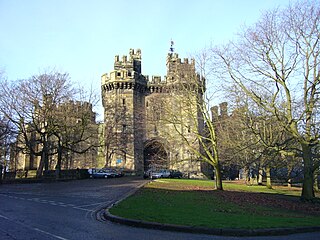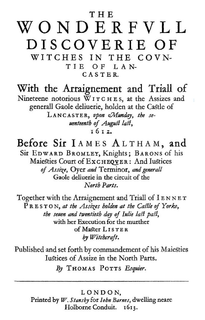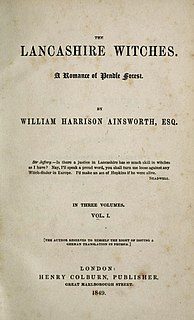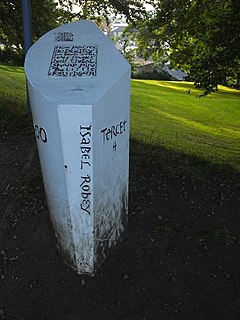Related Research Articles

A witch-hunt, or a witch purge, is a search for people who have been labeled witches or a search for evidence of witchcraft. The classical period of witch-hunts in Early Modern Europe and Colonial America took place in the Early Modern period or about 1450 to 1750, spanning the upheavals of the Reformation and the Thirty Years' War, resulting in an estimated 35,000 to 50,000 executions. The last executions of people convicted as witches in Europe took place in the 18th century. In other regions, like Africa and Asia, contemporary witch-hunts have been reported from sub-Saharan Africa and Papua New Guinea, and official legislation against witchcraft is still found in Saudi Arabia and Cameroon today.

Matthew Hopkins was an English witch-hunter whose career flourished during the English Civil War. He claimed to hold the office of Witchfinder General, although that title was never bestowed by Parliament, and was mainly active in East Anglia.

Pendle Hill is in the east of Lancashire, England, near the towns of Burnley, Nelson, Colne, Brierfield, Clitheroe and Padiham. Its summit is 557 metres (1,827 ft) above mean sea level. It gives its name to the Borough of Pendle. It is an isolated hill in the Pennines, separated from the South Pennines to the east, the Bowland Fells to the northwest, and the West Pennine Moors to the south. It is included in a detached part of the Forest of Bowland Area of Outstanding Natural Beauty.

Samlesbury is a village and civil parish in South Ribble, Lancashire, England. Samlesbury Hall, a historic house, is in the village, as is Samlesbury Aerodrome and a large modern brewery owned by Anheuser-Busch InBev. The population at the 2011 census was 1,206.
The Late Lancashire Witches is a Caroline-era stage play and written by Thomas Heywood and Richard Brome, published in 1634. The play is a topical melodrama on the subject of the witchcraft controversy that arose in Lancashire in 1633.

The Bury St Edmunds witch trials were a series of trials conducted intermittently between the years 1599 and 1694 in the town of Bury St Edmunds in Suffolk, England.

Alice Nutter was an English woman accused and hanged as a result of the Pendle witch hunt. Her life and death are commemorated by a statue in the village of Roughlee in the Pendle district of Lancashire.

The Northamptonshire witch trials mainly refer to five executions carried out on 22 July 1612 at Abington Gallows, Northampton. In 1612 at the Lent Assizes held in Northampton Castle a number of women and a man were tried for witchcraft of various kinds, from murder to bewitching of pigs. There are two main accounts of these witches being tried. However they differ on how many witches were tried, who they were and exactly what they were supposed to have done.

The trials of the Pendle witches in 1612 are among the most famous witch trials in English history, and some of the best recorded of the 17th century. The twelve accused lived in the area surrounding Pendle Hill in Lancashire, and were charged with the murders of ten people by the use of witchcraft. All but two were tried at Lancaster Assizes on 18–19 August 1612, along with the Samlesbury witches and others, in a series of trials that have become known as the Lancashire witch trials. One was tried at York Assizes on 27 July 1612, and another died in prison. Of the eleven who went to trial – nine women and two men – ten were found guilty and executed by hanging; one was found not guilty.

Robert Poole is a UK-based historian, currently Professor of History at the University of Central Lancashire, Preston. He gained his PhD from the University of Lancaster in 1986, where he was associated with Prof Harold Perkin's Centre for Social History, organising the 1996 conference of the Social History Society on 'Time and the Construction of the Past'. He has also held positions at the universities of Keele, Edge Hill and Cumbria. He has also been Leverhulme Senior Visiting Research Fellow at the University of Manchester (2000-1), an Associate of the Centre for the History of Science, Technology and Medicine, University of Manchester (2010–17), an associate of 'The Future in the Stars' research programme, Friedrich-Meinecke Institut, Freie Universität Berlin (2012–16), and visiting Senior Research Fellow to the History Group, University of Hertfordshire (2013–15).

The Paisley witches, also known as the Bargarran witches or the Renfrewshire witches, were tried in Paisley, Renfrewshire, central Scotland, in 1697. Eleven-year-old Christian Shaw, daughter of the Laird of Bargarran, complained of being tormented by some local witches; they included one of her family's servants, Catherine Campbell, whom she had reported to her mother after witnessing her steal a drink of milk.

The Samlesbury witches were three women from the Lancashire village of Samlesbury – Jane Southworth, Jennet Bierley, and Ellen Bierley – accused by a 14-year-old girl, Grace Sowerbutts, of practising witchcraft. Their trial at Lancaster Assizes in England on 19 August 1612 was one in a series of witch trials held there over two days, among the most famous in English history. The trials were unusual for England at that time in two respects: Thomas Potts, the clerk to the court, published the proceedings in his The Wonderfull Discoverie of Witches in the Countie of Lancaster; and the number of the accused found guilty and hanged was unusually high, ten at Lancaster and another at York. All three of the Samlesbury women were acquitted.

The Wonderfull Discoverie of Witches in the Countie of Lancaster is the account of a series of English witch trials that took place on 18–19 August 1612, commonly known as the Lancashire witch trials. Except for one trial held in York they took place at Lancaster Assizes. Of the twenty men and women accused – amongst them the Pendle witches and the Samlesbury witches – eleven were found guilty and subsequently hanged; one was sentenced to stand in the pillory, and the rest were acquitted.

The Lancashire Witches is the only one of William Harrison Ainsworth's forty novels that has remained continuously in print since its first publication. It was serialised in the Sunday Times newspaper in 1848; a book edition appeared the following year, published by Henry Colburn. The novel is based on the true story of the Pendle witches, who were executed in 1612 for causing harm by witchcraft. Modern critics such as David Punter consider the book to be Ainsworth's best work. E. F. Bleiler rated the novel as "one of the major English novels about witchcraft".

Malkin Tower was the home of Elizabeth Southerns, also known as Demdike, and her granddaughter Alizon Device, two of the chief protagonists in the Lancashire witch trials of 1612.

In early modern Scotland, between the early 16th century and the mid-18th century, judicial proceedings concerned with the crimes of witchcraft took place as part of a series of witch trials in Early Modern Europe. In the late middle age there were a handful of prosecutions for harm done through witchcraft, but the passing of the Witchcraft Act 1563 made witchcraft, or consulting with witches, capital crimes. The first major issue of trials under the new act were the North Berwick witch trials, beginning in 1590, in which King James VI played a major part as "victim" and investigator. He became interested in witchcraft and published a defence of witch-hunting in the Daemonologie in 1597, but he appears to have become increasingly sceptical and eventually took steps to limit prosecutions.

The great Scottish witch hunt of 1649–50 was a series of witch trials in Scotland. It is one of five major hunts identified in early modern Scotland and it probably saw the most executions in a single year.
Edmund Hartley, dubbed the Tyldesley witch, was a cunning man who from 1595 until 1596 was alleged to have practised witchcraft at Cleworth Hall in Tyldesley, Lancashire. Hartley was hanged, twice, after a trial at Lancaster Assizes in March 1597.

The Lancashire Witches Walk is a 51-mile (82 km) long-distance footpath opened in 2012, between Barrowford and Lancaster, all in Lancashire, England. It starts at Pendle Heritage Centre in Barrowford before passing through the Forest of Pendle, the town of Clitheroe and the Forest of Bowland to finish at Lancaster Castle.

Margaret Aitken, known as the great witch of Balwearie, was an important figure in the great Scottish witchcraft panic of 1597 as her actions effectively led to an end of that series of witch trials. After being accused of witchcraft Aitken confessed but then identified hundreds of women as other witches to save her own life. She was exposed as a fraud a few months later and was burnt at the stake.
References
Notes
Citations
- ↑ Clayton (2007), p. 168
- 1 2 Clayton (2007), p. 171
- ↑ Hasted (1993), p. 2
- ↑ Sharpe (2002), p. 3
- ↑ Gibson (2002), p. 53
Bibliography
- Clayton, John A. (2007), The Lancashire Witch Conspiracy, Barrowford Press, ISBN 978-0-9553-8212-3
- Gibson, Marion (2002), "Thomas Potts's Dusty Memory: Reconstructing Justice in The Wonderfull Discoverie of Witches", in Poole, Robert (ed.), The Lancashire Witches: Histories and Stories, Manchester University Press, pp. 42–57, ISBN 978-0-7190-6204-9
- Hasted, Rachel A. C. (1993), The Pendle Witch Trial 1612, Lancashire County Books, ISBN 978-1-871236-23-1
- Sharpe, James (2002), "Introduction: The Lancaster witches in historical context", in Poole, Robert (ed.), The Lancashire Witches: Histories and Stories, Manchester University Press, pp. 1–18, ISBN 978-0-7190-6204-9